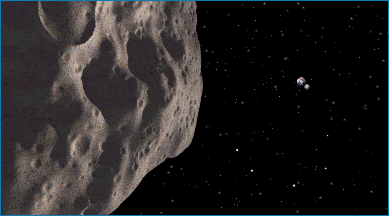| Asteroid Number | 1620 | | Asteroid Group | Apollo group | | Asteroid Family | Not applicable | | Composition Class | S-type (stony) | | Orbital Period | 1 year, 142 days | | Distance from the Sun | Semi-Major Axis: 186,288,278 km (1.25 AU)
Perihelion: 123,806,972 km (0.83 AU, approaching the orbit of Venus)
Aphelion: 248,769,585 km (1.66 AU, beyond the orbit of Mars) | | Eccentricity | 0.3354 | | Diameter | 2.6km (mean)
5.0km (longest axis) | | Notes | One of more than ten thousand Apollo asteroids, relatively small objects orbiting through the inner Solar System. Geographos crosses Earth's orbit, as well as that of Mars. It is classified as a potentially hazardous asteroid, but its orbit has been calculated for several centuries into the future, and it presents no immediate risk of a collision with Earth. |

A close view of the small asteroid Geographos. Among the stars of the Northern Crown, the
Earth and Moon are visible: this image represents the situation on 17 March 2008, when Geographos approached within a few thousand kilometres.
A small asteroid with an unusual shape, Geographos measures some five kilometres along its long axis, but has a cross-section diameter of only about two kilometres. This makes it one of the most extremely elongated objects known within the Solar System. Structurally, Geographos is a rocky body, and appears to be composed as a 'rubble pile', a collection of rocks held together by mutual gravity.
Geographos does not orbit the Sun within the main Asteroid Belt. The farthest it travels from the Sun is a distance of some 1.7 AU, which carries it out beyond the orbit of Mars, but on its inward journey it crosses the orbits of both Mars and Earth to reach its perihelion distance of just 0.8 AU. This makes Geographos an 'Earth-grazing' asteroid, at times approaching Earth within just a few thousand kilometres. The inclination of its orbit (by some 13° to the plane of the planets) means that there is little risk of a collision.
Geographos was discovered in 1951. Its name comes from the Greek for 'geographer', and was given to the asteroid in honour of the National Geographic Society.
|
|